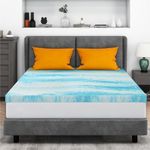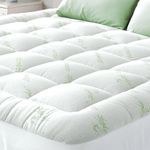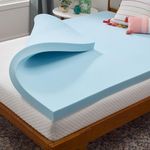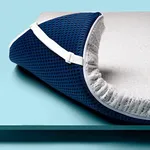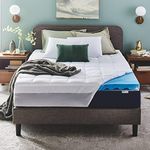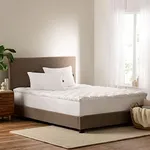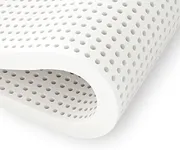Buying Guide for the Best Queen Bed Toppers
Choosing the right queen bed topper can significantly enhance your sleeping experience by providing additional comfort and support. When selecting a bed topper, it's important to consider various factors that align with your personal preferences and needs. Here are some key specifications to help you make an informed decision.MaterialThe material of a bed topper affects its comfort, support, and durability. Common materials include memory foam, latex, down, and fiberfill. Memory foam contours to your body, providing excellent support and pressure relief, making it ideal for those with joint pain. Latex is more responsive and cooler, suitable for those who sleep hot. Down offers a plush, luxurious feel but may not provide as much support, while fiberfill is a budget-friendly alternative that mimics down. Choose a material based on your comfort preference and any specific needs like support or temperature regulation.
ThicknessThickness determines the level of cushioning and support a bed topper provides. Toppers typically range from 1 to 4 inches thick. A 1-2 inch topper adds a slight layer of comfort and is suitable for those who want to enhance their mattress without significantly altering its feel. A 3-4 inch topper offers more substantial support and is ideal for those looking to soften a firm mattress or add more cushioning. Consider your current mattress condition and how much additional comfort you need when choosing the thickness.
DensityDensity, especially in memory foam toppers, affects the firmness and durability. It is measured in pounds per cubic foot (PCF). Low-density foam (2-3 PCF) is softer and less durable, suitable for occasional use or lighter individuals. Medium-density foam (3-5 PCF) offers a balance of comfort and support, making it a good choice for most sleepers. High-density foam (5+ PCF) is firmer and more durable, ideal for heavier individuals or those needing extra support. Choose a density based on your weight, sleeping position, and desired firmness.
FirmnessFirmness levels range from soft to extra firm and affect how the topper feels. A soft topper provides a plush, sinking feel, suitable for side sleepers who need pressure relief on their shoulders and hips. A medium-firm topper offers balanced support and comfort, ideal for back sleepers. A firm topper provides more support and less sinkage, suitable for stomach sleepers or those with back pain. Consider your sleeping position and any specific comfort needs when selecting the firmness level.
Temperature RegulationTemperature regulation is crucial for a comfortable night's sleep, especially if you tend to sleep hot. Some materials, like memory foam, can retain heat, while others, like latex or gel-infused foam, offer better breathability and cooling properties. Look for toppers with cooling technologies such as gel infusions, open-cell structures, or breathable covers if you are concerned about overheating. Choose a topper that aligns with your temperature preferences to ensure a comfortable sleep environment.
AllergiesIf you have allergies, it's important to choose a hypoallergenic bed topper. Materials like latex and certain synthetic fibers are naturally resistant to dust mites and other allergens. Down alternatives can also be a good choice for those allergic to feathers. Additionally, some toppers come with removable, washable covers that help maintain a clean and allergen-free sleeping surface. Consider your allergy sensitivities and look for hypoallergenic options to ensure a healthy sleep environment.
Motion IsolationMotion isolation is important if you share your bed with a partner and want to minimize disturbances from their movements. Memory foam and latex toppers typically offer excellent motion isolation, absorbing and reducing the transfer of motion across the bed. If you are a light sleeper or have a partner who moves frequently during the night, consider a topper with good motion isolation properties to ensure an undisturbed sleep.
